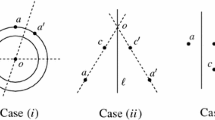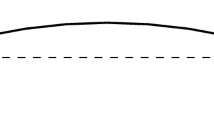Abstract
Let \({\mathcal {P}}\) be a set of n points in the Euclidean plane. We prove that, for any \(\varepsilon > 0\), either a single line or circle contains n/2 points of \({\mathcal {P}}\), or the number of distinct perpendicular bisectors determined by pairs of points in \({\mathcal {P}}\) is \(\Omega (n^{52/35 - \varepsilon })\), where the constant implied by the \(\Omega \) notation depends on \(\varepsilon \). This is progress toward a conjecture of Lund, Sheffer, and de Zeeuw, that either a single line or circle contains n/2 points of \({\mathcal {P}}\), or the number of distinct perpendicular bisectors is \(\Omega (n^2)\). The proof relies bounding the size of a carefully selected subset of the quadruples \((a,b,c,d) \in {\mathcal {P}}^4\) such that the perpendicular bisector of a and b is the same as the perpendicular bisector of c and d.




Similar content being viewed by others
Notes
The term additive energy, referring to the number of quadruples (a, b, c, d) in some underlying set of numbers such that \(a+b = c+d\), was coined by Tao and Vu [8]. Starting with the work of Elekes and Sharir [3], and Guth and Katz [6] on the distinct distance problem, the strategy of using geometric incidence bounds to obtain upper bounds on analogously defined energies has become indispensable in the study of questions about the number of distinct equivalent subsets.
References
Eran Agarwal, Pankaj K .and Nevo, János Pach, Rom Pinchasi, Micha Sharir, and Shakhar Smorodinsky. Lenses in arrangements of pseudo-circles and their applications. Journal of the ACM (JACM), 51(2):139–186, 2004.
Boris Aronov and Micha Sharir. Cutting circles into pseudo-segments and improved bounds for incidences. Discrete & Computational Geometry, 28(4):475–490, 2002.
György Elekes and Micha Sharir. Incidences in three dimensions and distinct distances in the plane. Combina- torics, Probability and Computing, 20(04):571–608, 2011.
Paul Erdős. On sets of distances of n points. The American Mathematical Monthly, 53(5):248–250, 1946.
Jacob Fox, János Pach, Ádám Sheffer, Andrew Suk, and Joshua Zahl. A semi-algebraic version of Zarankiewicz’s problem. Journal of the European Mathematical Society, 19(6):1785–1810, 2017.
Larry Guth and Nets Hawk Katz. On the Erdős distinct distances problem in the plane. Annals of Mathematics, 181(1):155–190, 2015.
Brandon Hanson, Ben Lund, and Oliver Roche-Newton. On distinct perpendicular bisectors and pinned distances in finite fields. Finite Fields and Their Applications, 37:240–264, 2016.
Terry Tao (http://mathoverflow.net/users/766/terrytao). Where did the term “additive energy” originate? MathOverflow. URL:http://mathoverflow.net/q/223962 (version: 2015-11-18).
Ben Lund, Adam Sheffer, and Frank De Zeeuw. Bisector energy and few distinct distances. Discrete & Computational Geometry, 56(2):337–356, 2016.
Adam Marcus and Gábor Tardos. Intersection reverse sequences and geometric applications. Journal of Combinatorial Theory, Series A, 113(4):675–691, 2006.
E. Szemerédi and W. T. Trotter. Extremal problems in discrete geometry. Combinatorica, 3(3):381–392, 1982.
Acknowledgements
I thank Brandon Hanson, Peter Hajnal, Oliver Roche-Newton, Adam Sheffer, and Frank de Zeeuw for many stimulating conversations on perpendicular bisectors and related questions. I thank Luca Ghidelli for pointing out an error in Lemma 7 in an earlier version. I thank the anonymous referees for numerous helpful comments on the writing and presentation of this paper.
Author information
Authors and Affiliations
Corresponding author
Additional information
Publisher's Note
Springer Nature remains neutral with regard to jurisdictional claims in published maps and institutional affiliations.
This work was supported by ERC Grant 267165 DISCONV.
Rights and permissions
About this article
Cite this article
Lund, B. A Refined Energy Bound for Distinct Perpendicular Bisectors. Ann. Comb. 24, 225–235 (2020). https://doi.org/10.1007/s00026-019-00478-z
Received:
Accepted:
Published:
Issue Date:
DOI: https://doi.org/10.1007/s00026-019-00478-z




